St. Martin Sleeve on Moselund tunic, = 13th c gamby pattern?
Moderator: Glen K
-
Mega Zenjirou Yoshi
- Archive Member
- Posts: 373
- Joined: Sun Jun 20, 2010 10:42 pm
- Location: Bethel CT, Barony Beyond the Mountain
St. Martin Sleeve on Moselund tunic, = 13th c gamby pattern?
Title basically says it all. Thinking about making a more functional and comfortable gambeson for SCA Heavy, and hopefully making it more plausibly period.
St. Martin's Sleeve is carbon dated to 1160 - 1270. There are a few extant tunics with similar slightly inset sleeves. Moselund seems like a good candidate design wise, is dated 1050 - 1150.
My last gamby was rectangular construction, with side gores and armpit gussets. Fustian shell, wool blanket, linen liner. 2" spacing between quilt lines. Lots of pockets in the lining for plastic plates and zoombang pads.
First one was a t-tunic tube, split up high, with armpit gussets. Linen shell and liner, bamboo batting. 2" spacing between quilt lines.
Still going to use my last version, it would be perfect for 100 Minutes War. But the wool padding is pretty heavy. I want something lighter and cooler for Pennsic, at least. So this one will be 7oz linen shell, bamboo batting, 3oz linen lining. Want to do 1" spacing between quilt lines, I'm not happy with 2" spacing, looks flat. Probably include pockets for hidden plates, again.
Anybody ever try a more complicated gambeson pattern for the 13th Century?
Article on a recreation of a gambeson using the sleeve of St. Martin (body of recreation is a straight tube, blech!) Been linked to before on the Archive, but a lot of those are broken now:
http://www.guerriersma.com/SiteOld/cont ... ai2017.pdf
Moselund tunic:
http://www.forest.gen.nz/Medieval/artic ... elund.html
St. Martin's Sleeve is carbon dated to 1160 - 1270. There are a few extant tunics with similar slightly inset sleeves. Moselund seems like a good candidate design wise, is dated 1050 - 1150.
My last gamby was rectangular construction, with side gores and armpit gussets. Fustian shell, wool blanket, linen liner. 2" spacing between quilt lines. Lots of pockets in the lining for plastic plates and zoombang pads.
First one was a t-tunic tube, split up high, with armpit gussets. Linen shell and liner, bamboo batting. 2" spacing between quilt lines.
Still going to use my last version, it would be perfect for 100 Minutes War. But the wool padding is pretty heavy. I want something lighter and cooler for Pennsic, at least. So this one will be 7oz linen shell, bamboo batting, 3oz linen lining. Want to do 1" spacing between quilt lines, I'm not happy with 2" spacing, looks flat. Probably include pockets for hidden plates, again.
Anybody ever try a more complicated gambeson pattern for the 13th Century?
Article on a recreation of a gambeson using the sleeve of St. Martin (body of recreation is a straight tube, blech!) Been linked to before on the Archive, but a lot of those are broken now:
http://www.guerriersma.com/SiteOld/cont ... ai2017.pdf
Moselund tunic:
http://www.forest.gen.nz/Medieval/artic ... elund.html
AKA: Lord Drogo Bryce of Middlefordshire
Gules, a calygreyhound head caboshed, or.
Effingham-Sensei said "The suck is strong in this one."
Gules, a calygreyhound head caboshed, or.
Effingham-Sensei said "The suck is strong in this one."
Re: St. Martin Sleeve on Moselund tunic, = 13th c gamby patt
Edit: So you want a "strong coat" with full-length sleeves not the sleeveless surcoat things?

When I look at this plate in the Maciejowski bible, I am intrigued that there are some pleats above the belt in the "strong quilted surcoats," but not below the belt.

This one shows a similar pattern. That suggests to me that you want the expansions to be relatively modest and starting somewhere below the armpit, with some extra circumference in the belly but just enough below the waist to let you walk. So you might not want or need the extra centre gores in the Moselund coat.
There are also the Sudanese quilted coats in the British Museum, Chris and Peter have photos and a pattern sketch.
It was 'good practice' from 1296 onwards to have at least one layer of linen interlining between the facing and the cotton. I made my blue doublet that way.

When I look at this plate in the Maciejowski bible, I am intrigued that there are some pleats above the belt in the "strong quilted surcoats," but not below the belt.

This one shows a similar pattern. That suggests to me that you want the expansions to be relatively modest and starting somewhere below the armpit, with some extra circumference in the belly but just enough below the waist to let you walk. So you might not want or need the extra centre gores in the Moselund coat.
There are also the Sudanese quilted coats in the British Museum, Chris and Peter have photos and a pattern sketch.
It was 'good practice' from 1296 onwards to have at least one layer of linen interlining between the facing and the cotton. I made my blue doublet that way.
Last edited by Sean M on Fri Jan 04, 2019 1:37 pm, edited 1 time in total.
DIS MANIBUS GUILLELMI GENTIS MCLEANUM FAMILIARITER GALLERON DICTI
VIR OMNIBUS ARTIBUS PERITUS
Check out Age of Datini: European Material Culture 1360-1410
VIR OMNIBUS ARTIBUS PERITUS
Check out Age of Datini: European Material Culture 1360-1410
Re: St. Martin Sleeve on Moselund tunic, = 13th c gamby patt
I also agree that you probably want a round armhole and a curved sleeve cap like the Moselund tunic to look like the Maciejowski Bible. The body should be about half your breast measurement wide at the shoulder with expansions under the armpit.
I wish I knew which guys in Maciejowski are wearing an "aketon and a gambeson" and which have a gambeson with separate quilted sleeves like at Busy St. Martin
I wish I knew which guys in Maciejowski are wearing an "aketon and a gambeson" and which have a gambeson with separate quilted sleeves like at Busy St. Martin
DIS MANIBUS GUILLELMI GENTIS MCLEANUM FAMILIARITER GALLERON DICTI
VIR OMNIBUS ARTIBUS PERITUS
Check out Age of Datini: European Material Culture 1360-1410
VIR OMNIBUS ARTIBUS PERITUS
Check out Age of Datini: European Material Culture 1360-1410
Re: St. Martin Sleeve on Moselund tunic, = 13th c gamby patt
I just checked Tina Anderlini's article on the shirt of St. Louis, which briefly covers the aketon of his sister Isabelle of France. It is sleeveless but has rectangular front and back panels widened by trapezoidal gores at both sides. The armholes are curved and run through the front panel, across the top of the side gores, and up the back panel. So that is another quilted garment which has gores at the sides but not the centre front and centre back.
So it might be you can keep the body construction of your last one, and just make the armhole and sleeve more tailored.
So it might be you can keep the body construction of your last one, and just make the armhole and sleeve more tailored.
DIS MANIBUS GUILLELMI GENTIS MCLEANUM FAMILIARITER GALLERON DICTI
VIR OMNIBUS ARTIBUS PERITUS
Check out Age of Datini: European Material Culture 1360-1410
VIR OMNIBUS ARTIBUS PERITUS
Check out Age of Datini: European Material Culture 1360-1410
-
Mega Zenjirou Yoshi
- Archive Member
- Posts: 373
- Joined: Sun Jun 20, 2010 10:42 pm
- Location: Bethel CT, Barony Beyond the Mountain
Re: St. Martin Sleeve on Moselund tunic, = 13th c gamby patt
Yup, was planning on skipping the center gores.Sean M wrote:When I look at this plate in the Maciejowski bible, I am intrigued that there are some pleats above the belt in the "strong quilted surcoats," but not below the belt.
...
That suggests to me that you want the expansions to be relatively modest and starting somewhere below the armpit, with some extra circumference in the belly but just enough below the waist to let you walk. So you might not want or need the extra centre gores in the Moselund coat.
Sean M wrote:It was 'good practice' from 1296 onwards to have at least one layer of linen interlining between the facing and the cotton. I made my blue doublet that way.
It's an experiment. I'm certainly hoping to get nice lines out of it.Sean M wrote:I also agree that you probably want a round armhole and a curved sleeve cap like the Moselund tunic to look like the Maciejowski Bible.
I feel your pain.Sean M wrote:I wish I knew which guys in Maciejowski are wearing an "aketon and a gambeson" and which have a gambeson with separate quilted sleeves like at Busy St. Martin
I'm hoping this design results in a slightly more tailored throughout. If it is successful, this will be the gambeson I use for base measurements for a tailored hauberk.Sean M wrote: I just checked Tina Anderlini's article on the shirt of St. Louis, which briefly covers the aketon of his sister Isabelle of France. It is sleeveless but has rectangular front and back panels widened by trapezoidal gores at both sides. The armholes are curved and run through the front panel, across the top of the side gores, and up the back panel. So that is another quilted garment which has gores at the sides but not the centre front and centre back.
So it might be you can keep the body construction of your last one, and just make the armhole and sleeve more tailored.
AKA: Lord Drogo Bryce of Middlefordshire
Gules, a calygreyhound head caboshed, or.
Effingham-Sensei said "The suck is strong in this one."
Gules, a calygreyhound head caboshed, or.
Effingham-Sensei said "The suck is strong in this one."
Re: St. Martin Sleeve on Moselund tunic, = 13th c gamby patt
Another reconstruction of the St. Maurice sleeve by Cité d'antan (also a (allmost) straight tube body, though).
-
tiredWeasel
- Archive Member
- Posts: 339
- Joined: Sun Mar 01, 2015 5:21 pm
- Location: the hills near Nuremberg, Germany
Re: St. Martin Sleeve on Moselund tunic, = 13th c gamby patt
Hey so I, finally, ordered some raw cotton batting (the closest I could find to real raw cotton) to make a test piece based on the construction of the St. Martin sleeve.
And man, it is thin. The original is said to be 8mm thick at most and that is two layers combined. Two layers of 100g/m² cotton batting sandwiched between two fabric layers and quilted in rows every 2,5-3cm is around 6mm (for one layer) thick so I guess thats a pretty close guess.
I'll try another piece with heavier batting and see how that turns out before starting with a complete gambeson.
Just wanted to thank you guys for posting these links!
I know about the extant sleeve but the linked .pdf really helped understand the construction.
And man, it is thin. The original is said to be 8mm thick at most and that is two layers combined. Two layers of 100g/m² cotton batting sandwiched between two fabric layers and quilted in rows every 2,5-3cm is around 6mm (for one layer) thick so I guess thats a pretty close guess.
I'll try another piece with heavier batting and see how that turns out before starting with a complete gambeson.
Just wanted to thank you guys for posting these links!
I know about the extant sleeve but the linked .pdf really helped understand the construction.
Re: St. Martin Sleeve on Moselund tunic, = 13th c gamby patt
I stuffed the blue pourpoint with cotton batting/Baumwollevlies too, but if you are looking for materials, Suppliers for Historical Crafts has a section on stuffing.tiredWeasel wrote:Hey so I, finally, ordered some raw cotton batting (the closest I could find to real raw cotton) ...
DIS MANIBUS GUILLELMI GENTIS MCLEANUM FAMILIARITER GALLERON DICTI
VIR OMNIBUS ARTIBUS PERITUS
Check out Age of Datini: European Material Culture 1360-1410
VIR OMNIBUS ARTIBUS PERITUS
Check out Age of Datini: European Material Culture 1360-1410
Re: St. Martin Sleeve on Moselund tunic, = 13th c gamby patt
Cotton upholstery rope (piping welt) is a better choice than batting. The 1" 25 mm rope quickly expand to about 3" diameter if you cut the binding netting.
ferrum ferro acuitur et homo exacuit faciem amici sui
Re: St. Martin Sleeve on Moselund tunic, = 13th c gamby patt
Ernst, could you explain your thinking?Ernst wrote:Cotton upholstery rope (piping welt) is a better choice than batting. The 1" 25 mm rope quickly expand to about 3" diameter if you cut the binding netting.
To me, it seems like if you want to use loose stuffing, use what they used: usually bowed cotton, in an emergency unspun silk/tow/wool OR scraps of linen cloth. (Either scatter it on the wrong side of the facing, then lay the lining on top and quilt together, or stretch the lining on a quilting frame, stitch down the middle, place a roll of wet, bowed cotton between facing and lining and stitch it down, repeat). If you want the convenience of sheets of stuffing, use quilt batting/wadding/Patchworkvlies (convenient but modern) OR many layers of linen cloth. (Baste them between facing and lining then stitch all the layers together).
DIS MANIBUS GUILLELMI GENTIS MCLEANUM FAMILIARITER GALLERON DICTI
VIR OMNIBUS ARTIBUS PERITUS
Check out Age of Datini: European Material Culture 1360-1410
VIR OMNIBUS ARTIBUS PERITUS
Check out Age of Datini: European Material Culture 1360-1410
Re: St. Martin Sleeve on Moselund tunic, = 13th c gamby patt
Cotton upholstery rope is already made into a roll. Although I doubt it was bowed, it still has enough loft to double in size once the mesh "casing" is cut. In this way, it functions almost exactly like the cotton in the the Charles VI pourpoint, without all of the prep work. Cotton batting is more like a layer of thin felt, not at all what we seem to find in the extant examples.Sean M wrote:Ernst, could you explain your thinking?Ernst wrote:Cotton upholstery rope (piping welt) is a better choice than batting. The 1" 25 mm rope quickly expand to about 3" diameter if you cut the binding netting.
To me, it seems like if you want to use loose stuffing, use what they used: usually bowed cotton, in an emergency unspun silk/tow/wool OR scraps of linen cloth. (Either scatter it on the wrong side of the facing, then lay the lining on top and quilt together, or stretch the lining on a quilting frame, stitch down the middle, place a roll of wet, bowed cotton between facing and lining and stitch it down, repeat). If you want the convenience of sheets of stuffing, use quilt batting/wadding/Patchworkvlies (convenient but modern) OR many layers of linen cloth. (Baste them between facing and lining then stitch all the layers together).
ferrum ferro acuitur et homo exacuit faciem amici sui
Re: St. Martin Sleeve on Moselund tunic, = 13th c gamby patt
It does not make it easy to vary the thickness of the stuffing in different areas, like the Charles VI garment or the pad-stitched doublets from the 16th and 17th century though ... even with batting, you can use four layers in some areas and one in others.Ernst wrote:Cotton upholstery rope is already made into a roll. Although I doubt it was bowed, it still has enough loft to double in size once the mesh "casing" is cut. In this way, it functions almost exactly like the cotton in the the Charles VI pourpoint, without all of the prep work.
It is a lot like what we have in the gold Charles du Blois pourpoint, the Pandolfo III Malatesta farsetto, and the helmet liners I have seen ... I have not completely read Catherine Lagier's article on the sleeve at Bussy, but it looks like they thought it was quilted on the same system: the stitches pass through facing, stuffing, and lining, not just through facing and lining like the red Charles VI garment which was "made twice" (fait à deux fois).Ernst wrote:Cotton batting is more like a layer of thin felt, not at all what we seem to find in the extant examples.
In the Bussy-St. Martin, Charles VI, and Pandolfo III Malatesta garments, it look like the tailor thought of "pieces" which were each assembled from multiple layers, finished along the seams (if time/budget permitted), laid back to back (if it was made twice on a frame), and then whip-stitched to neighbouring pieces.Catherine Lagier, La manche de l’Eglise de Bussy-Saint-Martin, 17 mai 2017, section 1ère étape wrote:La couture de matelassure (point a) est alors faite, sur la longueur partie A, en prenant la soie, la nappe de coton et le lin, à l'aide de points dont la partie visible va de 1 à 1,5 mm de longueur, à raison d'un point tous les 6 mm. On obtient ainsi une couture très serrée avec un fil qui risque moins d'être accroché, si on envisage l'hypothèse qu'un haubert était porté par-dessus. L'ensemble présente des tubes de 3 cm de largeur environ (photo 12)
The sewing of the stuffing (matelassure) (stitch a) along the length of part A is made by taking the silk, the blanket of cotton and the linen, with the help of stitches of which the visible part is from 1 to 1.5 mm in length, for the purpose of one stitch every 6 mm. In this way one creates a very tight sewing with one thread which is less likely to be hooked, if one imagines the possibility that a hauberk was worn on top. The assemblage presents tubes about 3 cm in width (photo 12)
I think she is saying is that the edges of each piece of 5 or 6 layers (facing, cotton, 1 or 2 layers of linen, cotton, lining) are not finished.Catherine Lagier, La manche de l’Eglise de Bussy-Saint-Martin, 17 mai 2017, section D wrote:
Le bon état de conservation met en évidence le caractère homogène des coutures: les mêmes fils se retrouvent sur la manche, le fragment et le gant, et parfois les mêmes points. Deux points sont utilisés pour réaliser l'assemblage des tissus et des différentes parties de la manche: le point devant (ou avant) destiné à solidariser des épaisseurs de tissu sur leur longueur, et le point de surjet qui les réunit sur leur tranche. Aucune trace de point de surfilage n'a été observée alors que des bords à vif sont visibles, en particulier pour les épaisseurs de lin à l'intérieur de la manche dans la Partie A. La soie elle, présente des lisières de chaque côté de la manche.
The good state of conservation made the homogeneous character of the sewing very evident: the same threads are found in the sleeve, the fragment, and the glove, and occasionally the same stitches. Two stitches were used to join the textiles and the different parts of the sleeve: the running stitch (point devant [ou avant]), intended to stabilize the layers of textile along their length, and the whipstitch (point de surjet) which joined them at their edge. No trace of overstitch (point de surfilage) has been noticed, even though the upright edges (bords à vif) are visible, especially for the layers of linen on the interior of the sleeve in part A. The silk presents its borders/selvages at every side of the sleeve.
Pont Avant

Pont de Surjet

Pont de Surfilage

DIS MANIBUS GUILLELMI GENTIS MCLEANUM FAMILIARITER GALLERON DICTI
VIR OMNIBUS ARTIBUS PERITUS
Check out Age of Datini: European Material Culture 1360-1410
VIR OMNIBUS ARTIBUS PERITUS
Check out Age of Datini: European Material Culture 1360-1410
-
tiredWeasel
- Archive Member
- Posts: 339
- Joined: Sun Mar 01, 2015 5:21 pm
- Location: the hills near Nuremberg, Germany
Re: St. Martin Sleeve on Moselund tunic, = 13th c gamby patt
Ernst, there two types of cotting batting - one is like felt, pretty dense and not that thick. but the other one is pretty fluffy. I handled both types and used the version with extra fluff for the test piece - in fact that one comes pretty close to raw cotton.
Re: St. Martin Sleeve on Moselund tunic, = 13th c gamby patt
I've done a project like yours, Mega, and run into a few relevant challenges. But first:
Sourcing the closest possible representation of raw cotton in my part of the world, I had to give up on cotton batting for quilts ("bomullsvatt") because here it looks like fluffy wool blankets and has syntetic fibres added. They make up a small percentage, but tie the fibers together and give added springiness, both properties you don't want in your padding. My solution was medical sterilized cotton wadding. A better option might have been "fettvatt", Medical cotton with its fats retained. Off course, ecological raw cotton would have been great, but to expensive in our part of the world.
I made mine based on the minimum requirements of the 1311 Paris ordinances (1,5 kg raw cotton for a garment) and royal accounts giving a base layer of linen, cotton wadding, linen and silk taffeta cover. I stitched through the layer of cotton like the Bussy sleeve (and probably the Lübeck waffenrocks), but in contrast to Lagier and Cornetet i did it on a frame the size of my largest piece for better control with the distribution of cotton. The bottom layer of linen was drawn tight before adding the other layers on top. I added 500 g cotton on each frame, front, back and gussets, and corresponding thickness for the sleeves. With some removed for the final tayloring, I ended up with slightly more than 1,5 kg, comprising a ca 3-4 mm thick garment after quilting but without further compression.

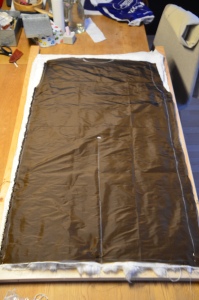
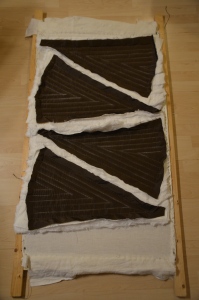
I quilted by starting with a line in the centre and sides, before halving again and again to avoid pushing the stuffing around.
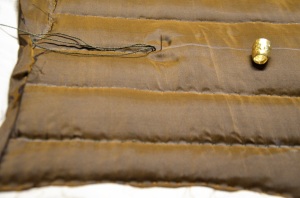
For joining the quilted parts, I used the method from Isabelle's aketon, with the inner and outer covers sewn together separately to get a continous layer of cotton. Everything was done from the outside, joining the inner covers with a running stitch before joining the outer covers with either a hidden or overcast stitch. For the sleeves, i finished the edges first before joining the inner and outer layers separatly.
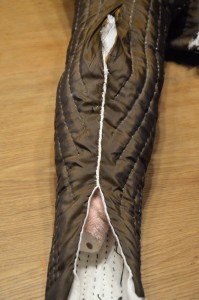
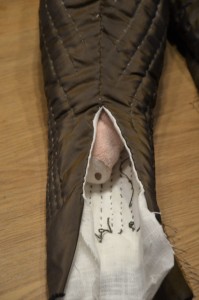
In my opinion, you cannot leave out the front and back split gussets if you want to avoid that unseemly and vulnerable gaping split so often seen in recreations but not in period art.
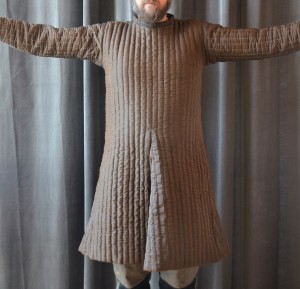
I believe the Charles of Blois pourpoint only has small fragments of the cotton stuffing remaining, making conclusions about its nature difficult. I would love to be proved wrong, though. The Pandolfo farsetto is according to carloni stuffed with something else: "The padding of the doublet, composed of waste animal and vegetable fibers (i.e. silk, wool, hemp, linen and cotton) is retained between two linen cloths; sleeves, neck and fold are embellished by a very close decorative stitching." With the Bussy sleeve, the padding in neither of the three garments can be said to look like Mart's description of it as thin felt, but as Weasel says, there are more types of cotton batting. I off course agree with Sean on the method of quilting through the batting, though.Sean M wrote:It is a lot like what we have in the gold Charles du Blois pourpoint, the Pandolfo III Malatesta farsetto, and the helmet liners I have seen ... I have not completely read Catherine Lagier's article on the sleeve at Bussy, but it looks like they thought it was quilted on the same system: the stitches pass through facing, stuffing, and lining, not just through facing and lining like the red Charles VI garment which was "made twice" (fait à deux fois).Ernst wrote:Cotton batting is more like a layer of thin felt, not at all what we seem to find in the extant examples.
Sourcing the closest possible representation of raw cotton in my part of the world, I had to give up on cotton batting for quilts ("bomullsvatt") because here it looks like fluffy wool blankets and has syntetic fibres added. They make up a small percentage, but tie the fibers together and give added springiness, both properties you don't want in your padding. My solution was medical sterilized cotton wadding. A better option might have been "fettvatt", Medical cotton with its fats retained. Off course, ecological raw cotton would have been great, but to expensive in our part of the world.
I made mine based on the minimum requirements of the 1311 Paris ordinances (1,5 kg raw cotton for a garment) and royal accounts giving a base layer of linen, cotton wadding, linen and silk taffeta cover. I stitched through the layer of cotton like the Bussy sleeve (and probably the Lübeck waffenrocks), but in contrast to Lagier and Cornetet i did it on a frame the size of my largest piece for better control with the distribution of cotton. The bottom layer of linen was drawn tight before adding the other layers on top. I added 500 g cotton on each frame, front, back and gussets, and corresponding thickness for the sleeves. With some removed for the final tayloring, I ended up with slightly more than 1,5 kg, comprising a ca 3-4 mm thick garment after quilting but without further compression.



I quilted by starting with a line in the centre and sides, before halving again and again to avoid pushing the stuffing around.

For joining the quilted parts, I used the method from Isabelle's aketon, with the inner and outer covers sewn together separately to get a continous layer of cotton. Everything was done from the outside, joining the inner covers with a running stitch before joining the outer covers with either a hidden or overcast stitch. For the sleeves, i finished the edges first before joining the inner and outer layers separatly.


In my opinion, you cannot leave out the front and back split gussets if you want to avoid that unseemly and vulnerable gaping split so often seen in recreations but not in period art.

Re: St. Martin Sleeve on Moselund tunic, = 13th c gamby patt
Håvard, thanks for writing up this project! I don't have time for a close read and a full response right now, but I will say this.Håvard wrote:I believe the Charles of Blois pourpoint only has small fragments of the cotton stuffing remaining, making conclusions about its nature difficult. I would love to be proved wrong, though.
I spent about 6 hours examining the Charles de Blois garment in its vitrine in Prague, and I have seen photos of the inside, and where both fabrics are intact, there is definitely stuffing in between. There are some tears in the cloth of gold facing and the linen lining, and one cuff is badly damaged, but about 95% of the garment is intact.


Harmand and Leloir and Newton are a bit vague, but the article by Georges Bernage in Moyen Age says "The whole garment is padded (with an inner layer of cotton and silk batting held in place by tacking) to help it to fit well on the body." No past tense or perfect aspect. The catalogue entry on Joconde (numéro d'inventaire 30307) "Quant au jaque, nouveau vêtement de dessus également rembourré sur toute sa surface, avec une bourse de coton maintenue entre le tissu et la doublure par des piqûres invisibles sur l'endroit, il suit les courbes d'un corps devenu singulièrement agressif." (the jack, a new undergarment equally padded over its whole surface with a bourse of cotton held between the fabric and the lining with invisible stitches on the facing).
Maybe you are thinking about the Diego Cavanaglia garment where the online photos just show the silk outer layer?
DIS MANIBUS GUILLELMI GENTIS MCLEANUM FAMILIARITER GALLERON DICTI
VIR OMNIBUS ARTIBUS PERITUS
Check out Age of Datini: European Material Culture 1360-1410
VIR OMNIBUS ARTIBUS PERITUS
Check out Age of Datini: European Material Culture 1360-1410
Re: St. Martin Sleeve on Moselund tunic, = 13th c gamby patt
Thanks for the correction, Sean. Rereading Coatsworth et al 2017, Clothing the Past , I see that I've jumped to conclusions based on their reference to some dispute concerning the quilting of the Charles de Blois pourpoint, and realize the "dispute" is a reenactor quibble only:
Coatsworth et al 2017 wrote:The pourpoint is quilted with rows of horizontal linen stitching. There has been some dispute about whether the quilting is original, or the work of a conservator, but it appears that, whatever the conservator’s input, the original was indeed padded with cotton. [note: http://www.virtue.to/articles/extant.html accessed 15 March 2016, quoting: ‘I had confirmation from the person who did the conservation that the pourpoint was originally quilted with cotton. Very cordially, Vincent Cros, Bibliothèque Centre de Documentation, Musée des Tissus et Musée des Arts décoratifs de Lyon’.] Maximilien Durand states that each section was separately quilted before the garment was assembled.[note: It would be interesting to know if this includes what Tasha Kelly identifies as the narrow slices of cloth stitched alongside the larger pieces, or if they were quilted as one with the main pieces.]
